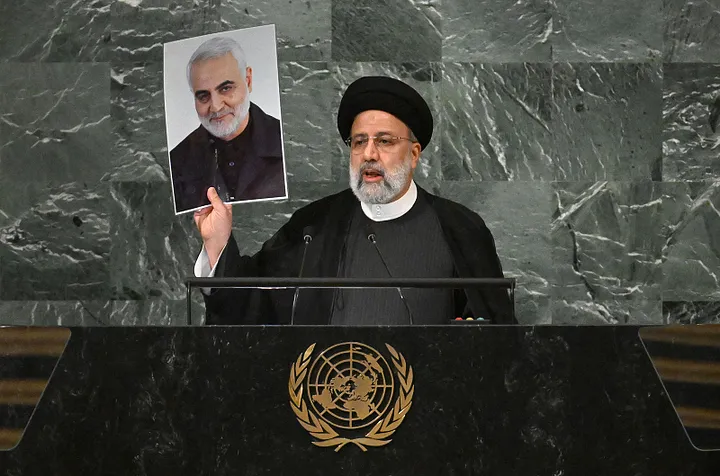Understanding the intricacies of international relations.
Qasem Soleimani, the late commander of the Quds Force of the Islamic Revolutionary Guard Corps (IRGC), was a significant figure in Iran’s military and political sphere. Throughout his career, he played pivotal roles in shaping the Middle East’s geopolitics, often putting him in indirect conflict with the United States and its allies.
Historical Context The U.S. and Iran have had a strained relationship since the 1979 Iranian Revolution. Events such as the U.S. embassy hostage crisis in Tehran and Iran’s nuclear ambitions have further complicated matters. In this context, Soleimani rose through the ranks and became instrumental in expanding Iran’s regional influence.
Proxy Conflicts Over the years, the U.S. and Iran have been involved in various proxy conflicts, with both nations supporting different factions. Soleimani was often seen as the mastermind behind Iran’s strategies in these situations, particularly in countries like Iraq, Syria, and Yemen.
Alleged Ties to Militant Groups Soleimani was believed to have ties with several Shiite militant groups across the Middle East. The U.S. has often accused the Quds Force of providing support to these groups, which have at times targeted American troops and interests.
CIA Connections? There have been speculations and rumors about interactions between Soleimani and the Central Intelligence Agency (CIA). However, concrete evidence of direct cooperation or collaboration is scant. What is clear is that both the CIA and Soleimani had mutual interests in certain regional issues, such as combating ISIS in Iraq and Syria. This sometimes led to indirect and unintended collaborations on the battlefield, where both sides fought a common enemy.
Conclusion Qasem Soleimani’s relationship with the U.S. was multifaceted and complex. While they were often on opposing sides, global politics and mutual interests occasionally aligned their strategies. As with many aspects of international relations, the full scope and details of their interactions remain shrouded in the intricacies of diplomacy and statecraft.
The indirect collaboration between the U.S. and forces led or influenced by Qasem Soleimani, particularly in the fight against ISIS, is an interesting aspect of Middle Eastern geopolitics. Let’s dive deeper:
Unintended Allies: The U.S. and Qasem Soleimani in the Fight Against ISIS
The rise of ISIS in the early 2010s posed a significant threat to both U.S. interests and Iranian influence in the Middle East. Both powers, despite their longstanding adversarial relationship, found themselves facing a common enemy.
Shared Interests in Iraq and Syria
Iraq: The rapid expansion of ISIS in Iraq in 2014 threatened both the U.S.-backed government in Baghdad and Iran’s influence in the Shiite-majority country. As a result, while the U.S. launched airstrikes against ISIS positions, Iranian-backed militias, often under the guidance of Soleimani, engaged the group on the ground.
Syria: The Syrian Civil War saw the Assad regime, an Iranian ally, pitted against various opposition groups, including ISIS. The U.S., while opposed to the Assad regime, also recognized the threat posed by ISIS. This led to a situation where both Iranian-backed forces and U.S.-backed groups were fighting against ISIS, albeit with different primary objectives.
Operational Independence While both powers were fighting against a common enemy, it’s crucial to note that there wasn’t direct coordination between the U.S. and Soleimani-led forces. Instead, they operated independently, albeit in a manner that sometimes complemented each other. For instance, U.S. airstrikes might weaken ISIS positions, which Iranian-backed militias would then capitalize on.
Risks and Tensions The situation was not without its tensions. There were instances where the proximity of U.S. forces and Iranian-backed militias led to concerns about potential confrontations. Both sides had to exercise caution to avoid accidental engagements with each other, focusing on the shared goal of defeating ISIS.
Post-ISIS Scenarios With the territorial defeat of ISIS, the dynamics changed. The U.S. and Iran returned to their adversarial positions, especially in places like Iraq, where both sought to influence the post-ISIS political landscape.
The fight against ISIS in the Middle East showcased the complexities of international politics. While the U.S. and forces influenced by Qasem Soleimani shared a common enemy in ISIS , their broader objectives and interests often diverged. The situation serves as a reminder of the fluid nature of alliances and enmities in the realm of geopolitics.
This deeper look provides a nuanced understanding of the indirect collaboration between the U.S. and Soleimani-led forces in the context of the fight against ISIS.
Direct collaboration between the United States and Qasem Soleimani is a topic of speculation and controversy, with limited verified information available. However, there are instances and periods during which their paths crossed, and their interests overlapped, even if indirectly. Here’s a closer look:
The U.S., Qasem Soleimani, and Moments of Overlapping Interests
After 9/11: In the immediate aftermath of the September 11 attacks, Iran, under its reformist president Mohammad Khatami, condemned the attacks. It’s been reported that Iran, through Soleimani’s Quds Force, provided the U.S. with intelligence on Taliban forces in Afghanistan. Both parties shared an interest in toppling the Taliban regime, which was hostile to Iran.
Battles Against ISIS: As previously mentioned, the rise of ISIS posed a significant threat to both U.S. and Iranian interests in the Middle East. While there wasn’t any direct military coordination, both powers were aware of each other’s movements and actions against ISIS. The mutual goal of defeating ISIS led to a situation where both the U.S. and Soleimani-led forces were operating in the same theater against the same enemy.
Communication Channels: There have been reports suggesting that messages were exchanged between the U.S. and Soleimani, especially during critical moments of tension. These communications were likely made through intermediaries or third-party nations, like Switzerland, which represents U.S. interests in Iran.
Iraqi Politics: Post the 2003 invasion of Iraq, the U.S. and Iran both sought to influence the political landscape of Iraq. While they backed different factions, there were moments when their interests converged, such as in the formation of certain coalition governments or in supporting specific Iraqi leaders. However, these instances were more about mutual interests than direct collaboration.
While there were periods where the U.S. and Qasem Soleimani had overlapping interests, especially in the fight against mutual enemies like the Taliban and ISIS, direct collaboration is harder to ascertain. Most of the interactions were indirect, characterized by a mutual understanding or tacit acknowledgment of each other’s roles in specific scenarios. However, direct collaboration, if any, remains a matter of speculation and is not documented in a manner that can be conclusively presented.
Switzerland represents U.S. interests in Iran through what’s called a “protecting power” arrangement. Here’s a breakdown of how this works and the history behind it:
Switzerland as the Protecting Power for U.S. Interests in Iran
Background: Diplomatic relations between the U.S. and Iran were severed in 1980 following the 1979 Iranian Revolution and the subsequent U.S. Embassy hostage crisis in Tehran. Since the U.S. and Iran do not have direct diplomatic relations, they rely on a third country to represent their interests in the other nation.
Role of a Protecting Power: A protecting power acts as an intermediary between two countries that do not have diplomatic relations. The protecting power’s primary role is to represent the interests of the “sending state” (in this case, the U.S.) in the “receiving state” (Iran) and vice versa.
Switzerland’s Role: Switzerland has been acting as the protecting power for U.S. interests in Iran since 1980. The Swiss Embassy in Tehran handles consular matters related to U.S. citizens in Iran and serves as a channel of communication between the U.S. and Iranian governments. This can involve passing messages or assisting with negotiations on various issues.
Challenges and Limitations: Acting as a protecting power can be a delicate balancing act, especially in situations of heightened tensions. The protecting power must ensure that its actions do not compromise its own bilateral relations with the receiving state. Switzerland, known for its neutrality and diplomatic expertise, has successfully managed this role for decades.
Other Instances: The concept of a protecting power is not unique to the U.S.-Iran relationship. During periods of conflict or strained relations, other countries have also relied on third-party nations to represent their interests. For example, during World War II, several neutral countries acted as protecting powers for belligerent nations.
The role of Switzerland as the protecting power for U.S. interests in Iran highlights the complexities of international diplomacy. In the absence of direct diplomatic ties, such arrangements become vital in ensuring communication, providing consular services, and sometimes facilitating negotiations between countries.
It’s worth noting that while Switzerland represents U.S. interests in Iran, Pakistan represents Iran’s interests in the U.S.
Countries that are perceived as neutral or have a long-standing tradition of diplomacy often serve as protecting powers. The choice of a protecting power usually depends on the mutual agreement of the countries involved and the willingness of the third country to act in this capacity. Here are some countries that have historically been used as protecting powers:
Switzerland: Switzerland, with its longstanding tradition of neutrality, is perhaps the most well-known country that has frequently served as a protecting power. Examples include representing U.S. interests in Iran and Cuban interests in the U.S.
Sweden: Sweden has also taken on the role of protecting power on several occasions. For example, during the Cold War, it represented U.S. interests in North Korea.
Spain: Spain has acted as a protecting power in the past, such as representing British interests in Argentina during and after the Falklands War.
Poland: Poland served as a protecting power for the U.S. in Iraq after the Gulf War in 1991.
Turkey: Turkey represented American interests in Libya for a period during the Obama administration.
Canada: Canada has taken on the role in the past, such as representing Israeli interests in Venezuela.
Belgium: Belgium has acted as a protecting power, such as representing German interests in Libya during the Gaddafi regime.
Czech Republic: For a time, the Czech Republic represented U.S. interests in Syria.
Pakistan: As mentioned earlier, Pakistan currently represents Iranian interests in the U.S.
Argentina: Argentina has represented Cuban interests in the U.S. in the past.
It’s important to note that the role of a protecting power is temporary and is meant to maintain essential diplomatic and consular functions between two countries that lack direct relations. The choice of a protecting power is based on trust, the third country’s diplomatic capabilities, and its ability to remain neutral in its mediating role.
All the countries listed – Switzerland, Sweden, Spain, Poland, Turkey, Canada, Belgium, Czech Republic, Pakistan, and Argentina – are diverse in many aspects, including geography, culture, and political systems. A common thread among them is their participation in various international organizations and treaties, their experiences with diplomacy, and their roles as protecting powers, as mentioned in the previous response.
A lesser-known common thread among these countries is their membership in the United Nations’ “Group of Friends of Mediation.” This group was co-initiated by Finland and Turkey in 2010 to promote mediation as a primary method of peaceful conflict resolution. The members advocate for the strengthening of mediation norms, standards, and capacities internationally. The group has contributed to the adoption of several UN resolutions related to mediation, emphasizing its importance in maintaining international peace and security.
The “Group of Friends of Mediation” was established to promote peaceful conflict resolution through mediation. Its primary objective is to enhance the use of mediation in resolving disputes and to strengthen the normative basis of mediation. Given this mandate, it’s implausible that the group would have a vested interest in promoting or benefiting from a war between any countries, including the United States and Iran.
However, if a conflict were to arise, the group might have an interest in facilitating dialogue and mediation to de-escalate tensions and promote peace. Their role would likely be to support diplomatic efforts to prevent or end hostilities, rather than to benefit from the conflict.
The “Group of Friends of Mediation” does not have a specific or predetermined point at which they cease their diplomatic efforts after relations change between countries. The cessation of efforts would depend on various factors:
Success of Mediation: If mediation efforts lead to a successful resolution of the conflict or a significant improvement in relations, the group may decide that their active involvement is no longer necessary.
Request of Involved Parties: If the countries involved in the dispute or conflict request the cessation of mediation efforts or express a desire to pursue other avenues of resolution, the group might respect those wishes and step back.
Change in the Nature of the Conflict: If the nature of the conflict changes, and it becomes evident that mediation is no longer the appropriate or effective approach, the group might reevaluate its involvement.
External Factors: International dynamics, the involvement of other diplomatic actors, or geopolitical changes might influence the group’s decision to continue or cease mediation efforts.
It’s essential to understand that the “Group of Friends of Mediation” acts as a supportive and advisory body. Its primary role is to promote mediation as a method of peaceful conflict resolution, provide expertise, and share best practices. Individual cases and conflicts would be assessed on a case-by-case basis, considering the unique dynamics and challenges of each situation.
As of January 2022, the “Group of Friends of Mediation” does not typically handle mediation directly in the way that a specific mediator or envoy would. Instead, it plays a supporting and advocacy role, promoting the use of mediation in conflict resolution and helping shape international norms and standards around mediation.
The group’s primary achievements have been at the normative level, particularly within the United Nations. They’ve been influential in pushing for several UN General Assembly resolutions on mediation. These efforts culminated in the General Assembly adopting a resolution in 2011 which recognized the importance of mediation in the peaceful settlement of disputes, conflict prevention, and resolution.
Because of their more indirect role, there aren’t “real-world” examples of the group starting and then officially ceasing specific mediation efforts as you might find with a specific envoy or mediator. Instead, their influence is more about creating an environment where mediation is recognized, supported, and used more frequently and effectively in international diplomacy.
That said, individual member countries of the “Group of Friends of Mediation” have been involved in specific mediation efforts around the world, and those efforts might have clear start and end points based on the dynamics of the specific conflict they’re addressing. But attributing such efforts directly to the collective action of the “Group of Friends of Mediation” would not be accurate.
The “Group of Friends of Mediation” doesn’t “enter a country” in the way a traditional mediator or envoy would. Instead, they work primarily within the United Nations framework to advocate for the use of mediation in conflict resolution.
Their efforts have led to the adoption of several UN resolutions that emphasize the importance of mediation. This means that the UN, influenced by the advocacy of the group, has a normative framework that supports mediation efforts globally.
While the “Group of Friends of Mediation” helps create and strengthen the normative environment for mediation, the actual act of mediation—sending envoys, facilitating talks, etc.—is typically handled by specific UN representatives or other international actors.
It’s not that the group gives the UN a “permanent seat at the table” but rather that the group’s efforts within the UN system help ensure that mediation is consistently considered as a viable tool for conflict resolution.
So, while the UN, influenced by the group’s advocacy, places a high value on mediation, whether or not the UN is involved in specific mediation efforts in a particular country depends on the unique circumstances and the consent of the parties involved.
An aspect of international diplomacy that’s worth noting: the involvement of third-party mediators, especially those linked to international organizations like the United Nations, can influence the dynamics of negotiations. Here’s a breakdown:
Consent-Based: Mediation, by its very nature, is consent-based. Both parties involved in a dispute must agree to the mediator’s involvement. This ensures that the mediator is seen as neutral and can effectively facilitate dialogue.
Influence vs. Control: While mediators can influence the process and dynamics of negotiations by setting agendas, proposing solutions, or facilitating dialogue, they don’t have “control” over the policy decisions of sovereign states. The final decisions always rest with the parties involved in the dispute.
UN’s Role: The United Nations, given its mandate to maintain international peace and security, often takes on or supports mediation roles in various conflicts. However, its involvement is typically predicated on the acceptance of both parties.
Group of Friends of Mediation: The group’s main role is to advocate for mediation within the UN framework. While their advocacy can shape how mediation is perceived and used in international relations, the group itself does not mediate conflicts.
High Stakes Policy Decisions: While mediators can offer options, insights, and frameworks for resolution, high stakes policy decisions remain the prerogative of the parties involved. Mediators can facilitate the decision-making process, but they cannot impose outcomes.
In conclusion, while third-party mediators, especially those linked to or influenced by international bodies like the UN, can shape the mediation process, the autonomy of the disputing parties remains central. The goal of mediation is to assist parties in finding common ground and mutually acceptable solutions, not to control the outcome.












